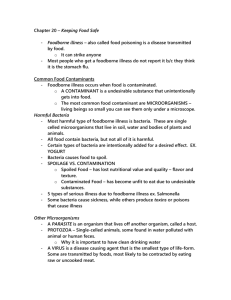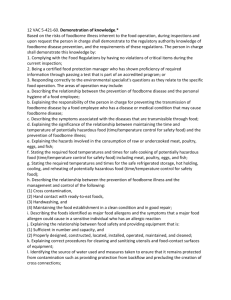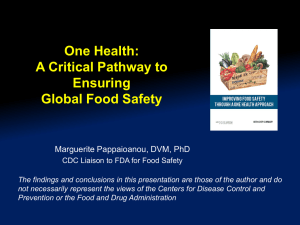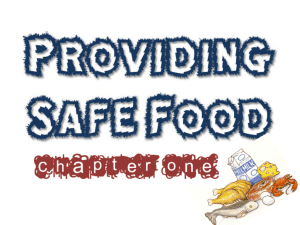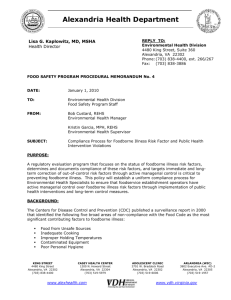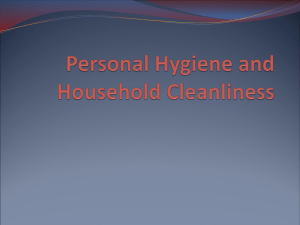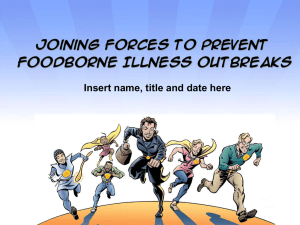Serving it Safe
advertisement
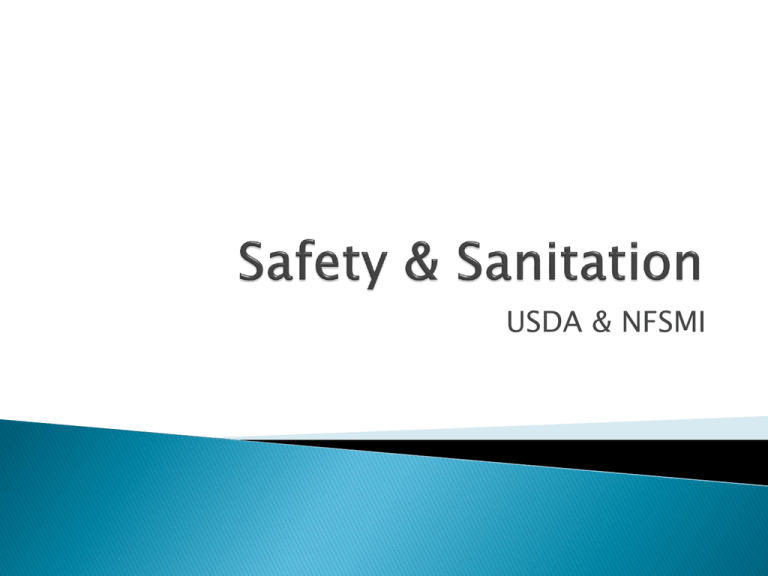
USDA & NFSMI You understand that: The training you are about to take does not cover the entire scope of the program, and that You are responsible for knowing and understanding all handbooks, manuals, alerts, notices and guidance, as well as any other forms of communication that provide further guidance, clarification or instruction on operating the program. Safety & Sanitation ◦ Importance of food safety in school nutrition programs ◦ Basics facts about microorganisms ◦ Characteristics of a food safe facility HACCP ◦ ◦ ◦ ◦ Discuss the purpose of a food safety program. Identify key components of a HACCP Plan. Learn and apply the Process Approach. Identify strategies to know current state of school food safety program. Three truths and one untruth Why is food safety a top Priority? What is foodborne illness and foodborne outbreak? ◦ Foodborne Illness: referred to as “food poisoning”, is a disease carried to people by food or water. A foodborne illness can only be confirmed with a lab analysis that identifies the source of the illness. ◦ Foodborne Outbreak: an incident in which two or more people experience the same illness symptoms after eating a common food. Biological Hazards Chemical Hazards Physical Hazards Wash hands thoroughly after using chemicals What happens in the body after a contaminated food has been eaten? How do harmful microorganisms contaminate foods? ◦ Sources Animals Food Handling Food Preparation Food Storage Heating Food What are the three main causes of a foodborne illness? Poor Personal Hygiene Abuse of the Time – Temperature Relationship Cross-contamination What are the responsibilities of the foodservice manager? ◦ Knowing & implementing State & local public health dept regulations regarding food safety & sanitation. ◦ Solving problems of non-compliance cited on sanitation inspections. ◦ Maintaining up-to-date knowledge regarding food safety & sanitation. ◦ Training & supervising employees on food safety. ◦ Holding employees responsible for following food safety requirements & guidelines. What are the responsibilities of the foodservice employee? ◦ Learning about food safety ◦ Following local or state food safety requirements ◦ Following guidelines such as: Monitoring as specified in the school’s food safety plan Taking corrective actions if standards are not met Keeping accurate records Communicating with foodservice manager to inform them about problems or areas that can be improved How should the FS Manager respond if symptoms of Foodborne Illness are reported to the foodservice? ◦ Be calm and cooperate with the health department ◦ Talk with your supervisor immediately to communicate the situation and seek additional guidance ◦ Stop serving the suspected food ◦ Keep samples of suspect foods. ◦ Cooperate with the health department to gather information. ◦ Report the information you were asked to assemble. ◦ Do not give medical advice, that should be left to the health professionals ◦ Direct all media inquiries to the appropriate designated school district representative. ◦ For those students who have reported symptoms of foodborne illness, parents should be contacted by personnel designated by the school or school district. What are the most common causes of foodborne illnesses? ◦ Microorganisms: tiny, living organisms that are so small they can be seen only with a microscope. ◦ Pathogens (Harmful Microorganisms = Illness) Bacteria Viruses ◦ Spoilage Microorganisms (May cause illness) Fungi (molds & yeasts) ◦ Parasites What are the major foodborne illnesses caused by bacteria & how can they be prevented? Botulism Campylobacteriosis E-coli Listeriosis Perfringens Salmonellosis Shigellosis Staphylococcal What are the major foodborne illnesses caused by viruses & how can they be prevented? Gastroenteritis from Norwalk Virus Calicivirus Hepatitis A What are the major foodborne illnesses caused by fungi & how can they be prevented? Molds Yeasts What are the major foodborne illnesses caused by parasites & how can they be prevented? Cyclosporiasis Giardiasis Trichinosis How do microorganisms grow? Conditions for growth… F A T T O M Time and Temperature Controlled for Safety (previously PHF) Foodborne microorganisms grow best in food that has a pH between 4.6 – 7.0 Temperature Danger Zone Rapid Bacterial Growth 41˚F and 135˚F Bacteria can double every 20 minutes. ◦ Aerobic bacteria need oxygen to grow ◦ Anaerobic grow when oxygen is absent ◦ The amount of moisture available in food for this growth is called water activity (aw) How can food safety be promoted through personal hygiene and work attire? Know why personal hygiene and work attire is important. Use guidelines for good personal hygiene. Dress for food safety success. Use common sense as a guide when working with food. How can food-safe facility be operated? Know the characteristics of a food-safe facility. Maintain clean floors, walls, & ceilings. Maintain a clean & sanitary serving line & stations. Maintain good ventilation Maintain clean employee restrooms How can food-safe facility be operated? Maintain clean and neat trash collection areas. Maintain an effective pest control program ◦ How often does your district perform pest control activities? ◦ Is it effective? ◦ Have you ever reported a pest problem? How should smallwares be cleaned and sanitized? Chemical sanitizing Heat sanitizing Sanitize smallwares in a Three compartment sinks Sanitize smallwares in a Mechanical dishwasher How should large equipment be cleaned and sanitized? 1. WASH 2. RINSE 3. SANITIZE IN PLACE Who is responsible for food safety? It’s EVERYBODY’S business!!! • Chlorine 50 ppm • Quats 200 ppm • Iodine 12.5-25 ppm 1 Wash 110°F (43°C) or higher 2 Rinse 3 Sanitize Hot water 171°F (77°C) or chemicals High-Temperature Machines ◦ Final sanitizing rinse must be at least 180°F (82°C) Chemical-Sanitizing Machines ◦ Follow guidelines provided by the manufacturer Checking Sanitizing Effectiveness (Safety!) Turn off and unplug Disassemble Clean & Sanitize ◦ ◦ ◦ ◦ Wash Rinse Sanitize (immerse, wipe or spray) Air dry Reassemble (Re-sanitize surfaces handled) How can foodborne illness be prevented in the eight steps of the foodservice process? (see handout) 1. 2. 3. 4. 5. 6. 7. 8. 9. Purchasing Receiving Storing Preparing Cooking Serving & Holding Cooling Reheating (Transporting) FOOD SAFETY CHECKLIST: HACCP-Based SOPs Food Safety Checklist




